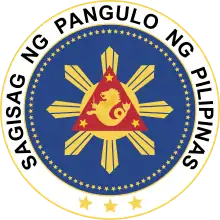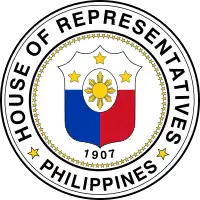Manuel Roxas
Manuel Acuña Roxas (Tagalog pronunciation: [aˈkuɲa ˈɾohas]; born Manuel Roxas y Acuña; January 1, 1892 – April 15, 1948) was the fifth President of the Philippines who served from 1946 until his death in 1948. He briefly served as the third and last President of the Commonwealth of the Philippines from May 28, 1946 to July 4, 1946 and then became the first President of the independent Third Philippine Republic after the United States ceded its sovereignty over the Philippines.
Manuel A. Roxas | |
|---|---|
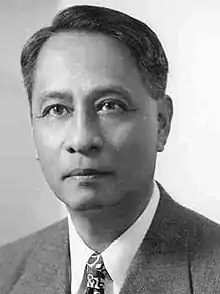 | |
| 5th President of the Philippines (1st President of the Third Philippine Republic) | |
| In office May 28, 1946 – April 15, 1948 | |
| Vice President | Elpidio Quirino |
| Preceded by | Sergio Osmeña |
| Succeeded by | Elpidio Quirino |
| 2nd President of the Senate of the Philippines | |
| In office July 9, 1945 – May 25, 1946 | |
| President | Sergio Osmeña |
| Preceded by | Manuel L. Quezon |
| Succeeded by | José Avelino |
| Senator of the Philippines | |
| In office July 9, 1945 – May 25, 1946 | |
| Executive Secretary | |
| In office December 24, 1941 – March 26, 1942 | |
| President | Manuel L. Quezon |
| Preceded by | Jorge B. Vargas |
| Succeeded by | Arturo Rotor |
| Secretary of Finance | |
| In office August 21, 1941 – December 29, 1941 | |
| President | Manuel L. Quezon |
| Preceded by | Antonio de las Alas |
| Succeeded by | Serafin Marabut |
| 2nd Speaker of the Philippine House of Representatives | |
| In office 1922–1933 | |
| Preceded by | Sergio Osmeña |
| Succeeded by | Quintin Paredes |
| Member of the Philippine House of Representatives from Capiz's 1st District | |
| In office 1922–1938 | |
| Preceded by | Antonio Habana |
| Succeeded by | Ramon A. Arnaldo |
| Governor of Capiz | |
| In office 1919–1922 | |
| Member of the Capiz Municipal Council | |
| In office 1917–1919 | |
| Personal details | |
| Born | Manuel Roxas y Acuña January 1, 1892 Capiz (now Roxas City), Capiz, Captaincy General of the Philippines |
| Died | April 15, 1948 (aged 56) Clark Air Base, Philippines |
| Cause of death | Heart attack |
| Resting place | Manila North Cemetery, Santa Cruz, Manila, Philippines |
| Political party | Liberal (1946–1948) |
| Other political affiliations | Nacionalista (before 1946) |
| Spouse(s) | |
| Children | Gerardo Manuel Roxas Ruby Róxas |
| Alma mater | University of Manila University of the Philippines College of Law |
| Profession | Lawyer, Soldier |
| Signature | |
| Military service | |
| Nickname(s) | Manuel |
| Allegiance | |
| Branch/service | Philippine Commonwealth Army |
| Years of service | 1941–1945 |
| Battles/wars | World War II * Japanese Occupation of the Philippines (1942–1945) * Philippines Campaign (1944–1945) |
.svg.png.webp) Coat of arms of Manuel Roxas | |
Political career
Roxas occupied more important positions in the Philippine government than any other Filipino had ever held before him. Starting in 1917, he was a member of the municipal council of Capiz.[1] He then became the youngest governor of Capiz and served in this capacity from 1919 to 1922.
He was elected to the Philippine House of Representatives in 1922, and for twelve consecutive years was Speaker of the House. He was a member of the Constitutional Convention from 1934 to 1935, Secretary of Finance, Chairman of the National Economic Council, Chairman of the National Development Company and many other government corporations and agencies, Brigadier General in the USAFFE, recognized guerilla leader and military leader of the Philippine Commonwealth Army.
Senate

After the amendments to the 1935 Philippine Constitution were approved in 1941, he was elected (1941) to the Philippine Senate, but was unable to serve until 1945 because of the outbreak of World War II.
Having enrolled prior to World War II as an officer in the reserves, he was made liaison officer between the Commonwealth government and the United States Army Forces in the Far East headquarters of General Douglas MacArthur. He accompanied President Quezon to Corregidor where he supervised the destruction of Philippine currency to prevent its capture by the Japanese. When Quezon left Corregidor, Roxas went to Mindanao to direct the resistance there. It was prior to Quezon's departure that he was made Executive Secretary and designated as successor to the presidency in case Quezon or Vice-President Sergio Osmeña were captured or killed.
Roxas was captured in 1942 by the Japanese invasion forces. He became chief advisor to José P. Laurel, but secretly sympathetic to the guerrilla movement,[2]:208–209 he passed information via Ramona (Mona) Snyder to Edwin Ramsey.[3]:57–58 He was returned by the military service of the Philippine Commonwealth Army joining the troops and military officers of men was beginning the liberation against the Japanese forces.
When the Congress of the Philippines was convened in 1945, the legislators elected in 1941 chose Roxas as Senate President.
Presidential election of 1946
| Presidential styles of Manuel Roxas | |
|---|---|
| Reference style | His Excellency |
| Spoken style | Your Excellency |
| Alternative style | Mr. President |
Prior to the Philippine national elections of 1946, at the height of the last Commonwealth elections, Senate President Roxas and his friends left the Nacionalista Party and formed the Liberal Party.[4] Roxas became their candidate for president and Elpidio Quirino for vice-president. The Nacionalistas, on the other hand, had Osmeña for president and Senator Eulogio Rodriguez for vice-president. Roxas had the staunch support of General MacArthur. Osmeña refused to campaign, saying that the Filipino people knew of his reputation. On April 23, 1946, Roxas won 54 percent of the vote, and the Liberal Party won a majority in the legislature.[5]
Last President of the Commonwealth
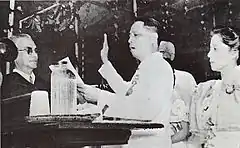
Roxas served as the President of the Commonwealth of the Philippines in a brief period, from May 28, 1946 to July 4, 1946 during which time Roxas helped prepare the groundwork for an independent Philippines.
On May 8, 1946, prior to his inauguration, President-elect Roxas, accompanied by US High Commissioner Paul V. McNutt, left for the United States.
On May 28, 1946, Roxas was inaugurated as the last President of the Commonwealth of the Philippines. The inaugural ceremonies were held in the ruins of the Legislative Building (now part of the National Museum of the Philippines) and were witnessed by about 200,000 people. In his address, he outlined the main policies of his administration, mainly: closer ties with the United States; adherence to the newly created United Nations; national reconstruction; relief for the masses; social justice for the working class; the maintenance of peace and order; the preservation of individual rights and liberties of the citizenry; and honesty and efficiency of government.
On June 3, 1946, Roxas appeared for the first time before a joint session of Congress to deliver his first State of the Nation Address. Among other things, he told the members of the Congress the grave problems and difficulties the Philippines face and reported on his special trip to the United States to discuss the approval for independence.[6]
On June 21, he reappeared in front of another joint session of the Congress and urged the acceptance of two laws passed by the Congress of the United States on April 30, 1946—the Tydings–McDuffie Act, of Philippine Rehabilitation Act, and the Bell Trade Act or Philippine Trade Act.[7] Both recommendations were accepted by the Congress.
First President of the Third Republic (1946–1948)
Manuel Roxas' term as the President of the Commonwealth ended on the morning of July 4, 1946, when the Third Republic of the Philippines was inaugurated and independence from the United States proclaimed. The occasion, attended by some 300,000 people, was marked by the simultaneous lowering of the Stars and Stripes and raising of the National Flag, a 21-gun salute, and the pealing of church bells. Roxas then swore the Oath of Office as the first President of the new Republic.
The inaugural ceremonies took place at Luneta Park in the City of Manila. On the Grandstand alone were around 3,000 dignitaries and guests, consisting of President Roxas, Vice-President Quirino, their respective parties and the Cabinet; the last High Commissioner to the Philippines and first Ambassador to the Philippines Paul McNutt; General Douglas MacArthur (coming from Tokyo); United States Postmaster General Robert E. Hannegan; a delegation from the United States Congress led by Maryland Senator Millard Tydings (author of the Tydings–McDuffie Act) and Missouri Representative C. Jasper Bell (author of the Bell Trade Act); and former Civil Governor-General Francis Burton Harrison.
Presidency
Administration and cabinet
| ||||||||||||||||||||||||||||||||||||||||||||||||||||||||||||||||||||||||||||||
Economy
| Population | |
|---|---|
| 1948 | 19.23 million |
| Gross Domestic Product (1985 constant prices) | |
| 1947 | |
| Growth rate, 1947–48 | 39.5% |
| Per capita income (1985 constant prices) | |
| 1947 | |
| Total exports | |
| 1947 | |
| Exchange rates | |
| 1 US$ = Php 2.00 1 Php = US$ 0.50 | |
| Sources: Philippine Presidency Project Malaya, Jonathan; Eduardo Malaya. So Help Us God... The Inaugurals of the Presidents of the Philippines. Anvil Publishing, Inc. | |
No sooner had the fanfare of the independence festivities ended that the government and the people quickly put all hands to work in the tasks of rescuing the country from its dire economic straits. Reputed to be the most bombed and destroyed country in the world, the Philippines was in a sorry mess. Only Stalingrad and Warsaw, for instance, could compare with Manila in point of destruction. All over the country more than a million people were unaccounted for. The war casualties as such could very well reach the two million mark. Conservative estimates had it that the Philippines had lost about two thirds of her material wealth.[8]
The country was facing near bankruptcy.[8] There was no national economy, no export trade. Indeed, production for exports had not been restored. On the other hand, imports were to reach the amount of three million dollars. There was need of immediate aid from the United Nations Relief and Rehabilitation Administration. Something along this line was obtained. Again, loans from the United States, as well as some increase in the national revenues, were to help the new Republic.[8]
President Roxas, with bold steps, met the situation with the same confidence he exuded in his inaugural address, when he said: "The system of free but guided enterprise is our system". Among the main remedies proposed was the establishment of the Philippine Rehabilitation Finance Corporation. This entity would be responsible for the construction of twelve thousand houses and for the grant of easy-term loans in the amount of 177,000,000 pesos. Another proposal was the creation of the Central Bank of the Philippines to help stabilize the Philippine dollar reserves and coordinate and the nations banking activities gearing them to the economic progress.
Concentrating on the sugar industry, President Roxas would exert such efforts as to succeed in increasing production from 13,000 tons at the time of the Philippine liberation to an all-high of one million tons.[8]
Reconstruction after the war
The postwar Philippines had burned cities and towns, ruined farms and factories, blasted roads and bridges, shattered industries and commerce, and thousands of massacred victims. The war had paralyzed the educational system, where 80% of the school buildings, their equipment, laboratories and furniture were destroyed.[9] Numberless books, invaluable documents and works of art, irreplaceable historical relics and family heirlooms, hundreds of churches and temples were burned. The reconstruction of the damaged school buildings alone cost more than Php 126,000,000,000.
The new Republic began to function on an annual deficit of over Php 200,000,000 with little prospect of a balanced budget for some years to come.[10] Manila and other cities then were infested with criminal gangs which used techniques of American gangsters in some activities–bank holdups, kidnapping and burglaries. In rural regions, especially the provinces of Central Luzon and the Southern Tagalog regions, the Hukbalahaps and brigands terrorized towns and barrios.
Agrarian Reform
In 1946, shortly after his induction to presidency, Manuel Roxas proclaimed the Rice Share Tenancy Act of 1933 effective throughout the country.[11] However problems of land tenure continued. In fact these became worse in certain areas.[11] Among the remedial measures enacted was Republic Act No. 1946 likewise known as the Tenant Act which provided for a 70–30 sharing arrangements and regulated share-tenancy contracts.[11] It was passed to resolve the ongoing peasant unrest in Central Luzon.[11]
Amnesty Proclamation
President Roxas, on January 28, 1948, granted full amnesty to all so-called Philippine collaborators, many of whom were on trial or awaiting to be tried, particularly former President José P. Laurel (1943–1945).[8] The Amnesty Proclamation did not apply to those "collaborators", who were charged with the commission of common crimes, such as murder, rape, and arson. The presidential decision did much[8] to heal a standing wound that somehow threatened to divide the people's sentiments. It was a much-called for measure to bring about a closer unity in the trying times when such was most needed for the progress of the nation.[8]
Huks outlawed
Disgusted with the crimes being committed by the guerilla movement Hukbó ng Bayan Laban sa Hapón (Nation's Army Against the Japanese, also called "the Huks") and possessing evidence of their subversion, Roxas issued a proclamation outlawing the Huk movement on March 6, 1948.[8] It had become an imperative in view of the resurgence of Huk depredations, following the unseating of the seven Communists, led by Huk Supremo Luis Taruc through acts of terrorism.[8]
Treaty of General Relations
On August 5, 1946, the Congress of the Philippines ratified the Treaty of General Relations that had been entered into by and between the Republic of the Philippines and the United States on July 4, 1946.[8] Aside from withdrawing her sovereignty from the Philippines and recognizing her independence, the Treaty reserved for the United States some bases for the mutual protection of both countries; consented that the United States represent the Philippines in countries where the latter had not yet established diplomatic representation; made the Philippines assume all debts and obligations of the former government in the Philippines; and provided for the settlement of property rights of the citizens of both countries.[8]
United States military bases

Although Roxas was successful in getting rehabilitation funds from the United States after independence, he was forced to concede military bases (23 of which were leased for 99 years), trade restriction for the Philippine citizens, and special privileges for U.S. property owner and investor.
Parity Rights Amendment
On March 11, 1947, Philippine voters, agreeing with Roxas, ratified in a nationwide plebiscite the "parity amendment" to the 1935 Constitution of the Philippines, granting United States citizens the right to dispose of and utilize Philippine natural resources, or parity rights.
Turtle and Mangsee Islands
On 19 September 1946 the Republic of the Philippines notified the United Kingdom that it wished to take over the administration of the Turtle Islands and the Mangesse Islands. Pursuant to a supplemental international agreement, the transfer of administration became effective on 16 October 1947.[12][13]
Assassination attempt
The night before the plebiscite, Roxas narrowly escaped assassination by Julio Guillen, a disgruntled barber from Tondo, Manila, who hurled a grenade at the platform on Plaza Miranda immediately after Roxas had addressed a rally.[14]
Controversies
His administration was marred by graft and corruption; moreover, the abuses of the provincial military police contributed to the rise of the left-wing (Huk) movement in the countryside. His heavy-handed attempts to crush the Huks led to widespread peasant disaffection.
The good record of the Roxas administration was marred by notable failures: the failure to curb graft and corruption in the government (as evidenced by the surplus war property scandal), the Chinese immigration scandal, the school supplies scandal and the failure to check and stop the communist Hukbalahap movement.
Death

Roxas did not finish his full four-year term. On the morning of April 15, 1948, Roxas delivered a speech before the United States Thirteenth Air Force. After the speech, he felt dizzy and was brought to the residence of Major General E.L. Eubank at Clark Field, Pampanga. He died later that night of a heart attack.[15][16] Roxas' term as president is thus the third shortest, lasting one year, ten months, and 18 days.
On April 17, 1948, two days after Roxas' death, Vice-President Elpidio Quirino took the oath of office as President of the Philippines.
On July 3, 1956, Roxas was posthumously awarded the Quezon Service Cross. The award was presented to his widow, Trinidad L. Roxas, by then Vice-President Carlos P. Garcia on behalf of President Magsaysay.[17]
Legacy
In his honour, various cities in the Philippines have been renamed after him, including Roxas, Oriental Mindoro, the first town to be named as such; Roxas City, Capiz; President Roxas, Capiz; President Roxas, Cotabato; and Roxas, Isabela. Dewey Boulevard in the Metro Manila was renamed in his memory, and he is currently depicted on the 100 Philippine peso bill.
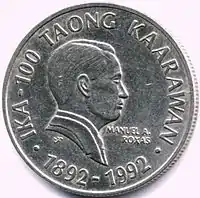 1992 Two Peso President Manuel Roxas Commemorative Coin
1992 Two Peso President Manuel Roxas Commemorative Coin.jpg.webp) 2017 One Hundred Peso banknote
2017 One Hundred Peso banknote Roxas Boulevard in Pasay City, named after the president
Roxas Boulevard in Pasay City, named after the president
Family and ancestry
| Ancestors of Manuel Roxas[18] | |||||||||||||||||||||||||||||||||||||||||||||||||||||||||||||||||||||||||||||||||||||||||||||||||||||||||||||||||||||||||||||||||||||||||||||||||||||||||||||||||||||||||||||||||||||||||||||||||||||||||||||||||||||||||||||||||||||||||||||||||||||||||||||||||||||||||||||||||||||||||||||||||||||||||||||||||||||||||||||||||||||||||||||||||||||||||||||||||||||||||||||||||||||||||||||||||||||||||||||||||||||||||||||||||||||||||||||||||||||||||||||||||||||||||||||||||||||||||||||||||||||||||||||||||||||||||||||||||||||||||||||||||||||||||||||||||||||||||||||||||||||||||||||||||||||||||||||||||||||||||||||||||||||||||||||||||||||||||||||||||||||||||||||||||||||||||||||||||||||||||||||||||||||||||||||||||||||||||||||||||||||||||||||||||||||||||||||||||||||||||||||||||||||||||||||||||||||||||||||||||||||||||||||||||||||||||||||||||||||||||||||||||||||||||||||||||||||||||||||||||||||||||||||||||||||||||||||||||||||||||||||||||||||||||||||||||||||||||||||||||||||||||||||||||||||||||||||||||||||||
|---|---|---|---|---|---|---|---|---|---|---|---|---|---|---|---|---|---|---|---|---|---|---|---|---|---|---|---|---|---|---|---|---|---|---|---|---|---|---|---|---|---|---|---|---|---|---|---|---|---|---|---|---|---|---|---|---|---|---|---|---|---|---|---|---|---|---|---|---|---|---|---|---|---|---|---|---|---|---|---|---|---|---|---|---|---|---|---|---|---|---|---|---|---|---|---|---|---|---|---|---|---|---|---|---|---|---|---|---|---|---|---|---|---|---|---|---|---|---|---|---|---|---|---|---|---|---|---|---|---|---|---|---|---|---|---|---|---|---|---|---|---|---|---|---|---|---|---|---|---|---|---|---|---|---|---|---|---|---|---|---|---|---|---|---|---|---|---|---|---|---|---|---|---|---|---|---|---|---|---|---|---|---|---|---|---|---|---|---|---|---|---|---|---|---|---|---|---|---|---|---|---|---|---|---|---|---|---|---|---|---|---|---|---|---|---|---|---|---|---|---|---|---|---|---|---|---|---|---|---|---|---|---|---|---|---|---|---|---|---|---|---|---|---|---|---|---|---|---|---|---|---|---|---|---|---|---|---|---|---|---|---|---|---|---|---|---|---|---|---|---|---|---|---|---|---|---|---|---|---|---|---|---|---|---|---|---|---|---|---|---|---|---|---|---|---|---|---|---|---|---|---|---|---|---|---|---|---|---|---|---|---|---|---|---|---|---|---|---|---|---|---|---|---|---|---|---|---|---|---|---|---|---|---|---|---|---|---|---|---|---|---|---|---|---|---|---|---|---|---|---|---|---|---|---|---|---|---|---|---|---|---|---|---|---|---|---|---|---|---|---|---|---|---|---|---|---|---|---|---|---|---|---|---|---|---|---|---|---|---|---|---|---|---|---|---|---|---|---|---|---|---|---|---|---|---|---|---|---|---|---|---|---|---|---|---|---|---|---|---|---|---|---|---|---|---|---|---|---|---|---|---|---|---|---|---|---|---|---|---|---|---|---|---|---|---|---|---|---|---|---|---|---|---|---|---|---|---|---|---|---|---|---|---|---|---|---|---|---|---|---|---|---|---|---|---|---|---|---|---|---|---|---|---|---|---|---|---|---|---|---|---|---|---|---|---|---|---|---|---|---|---|---|---|---|---|---|---|---|---|---|---|---|---|---|---|---|---|---|---|---|---|---|---|---|---|---|---|---|---|---|---|---|---|---|---|---|---|---|---|---|---|---|---|---|---|---|---|---|---|---|---|---|---|---|---|---|---|---|---|---|---|---|---|---|---|---|---|---|---|---|---|---|---|---|---|---|---|---|---|---|---|---|---|---|---|---|---|---|---|---|---|---|---|---|---|---|---|---|---|---|---|---|---|---|---|---|---|---|---|---|---|---|---|---|---|---|---|---|---|---|---|---|---|---|---|---|---|---|---|---|---|---|---|---|---|---|---|---|---|---|---|---|---|---|---|---|---|---|---|---|---|---|---|---|---|---|---|---|---|---|---|---|---|---|---|---|---|---|---|---|---|---|---|---|---|---|---|---|---|---|---|---|---|---|---|---|---|---|---|---|---|---|---|---|---|---|---|---|---|---|---|---|---|---|---|---|---|---|---|---|---|---|---|---|---|---|---|---|---|---|---|---|---|---|---|---|---|---|---|---|---|---|---|---|---|---|---|---|---|---|---|---|---|---|---|---|---|---|---|---|---|---|---|---|---|---|---|---|---|---|---|---|---|---|---|---|---|---|---|---|---|---|---|---|---|---|---|---|---|---|---|---|---|---|---|---|---|---|---|---|---|---|---|---|---|---|---|---|---|---|---|---|---|---|---|---|---|---|---|---|---|---|---|---|---|---|---|---|---|---|---|---|---|---|---|---|---|---|---|---|---|---|---|---|---|---|---|---|---|---|---|---|---|---|---|---|---|---|---|---|---|---|---|---|---|---|---|---|---|---|---|---|---|---|---|---|---|---|---|---|---|---|---|---|---|---|---|---|---|---|---|---|---|---|---|---|---|---|---|---|---|---|---|---|---|---|---|---|---|---|---|---|---|---|---|---|---|---|---|---|---|---|---|---|---|---|---|---|---|---|---|---|---|---|---|---|---|---|---|---|---|---|---|---|---|---|---|---|---|---|---|---|---|---|---|---|---|---|---|---|---|---|---|---|---|---|---|---|---|---|---|---|---|---|---|---|---|---|---|---|---|---|---|---|---|---|---|---|---|---|---|---|---|---|---|---|---|---|---|---|---|---|---|---|---|---|---|---|---|
| |||||||||||||||||||||||||||||||||||||||||||||||||||||||||||||||||||||||||||||||||||||||||||||||||||||||||||||||||||||||||||||||||||||||||||||||||||||||||||||||||||||||||||||||||||||||||||||||||||||||||||||||||||||||||||||||||||||||||||||||||||||||||||||||||||||||||||||||||||||||||||||||||||||||||||||||||||||||||||||||||||||||||||||||||||||||||||||||||||||||||||||||||||||||||||||||||||||||||||||||||||||||||||||||||||||||||||||||||||||||||||||||||||||||||||||||||||||||||||||||||||||||||||||||||||||||||||||||||||||||||||||||||||||||||||||||||||||||||||||||||||||||||||||||||||||||||||||||||||||||||||||||||||||||||||||||||||||||||||||||||||||||||||||||||||||||||||||||||||||||||||||||||||||||||||||||||||||||||||||||||||||||||||||||||||||||||||||||||||||||||||||||||||||||||||||||||||||||||||||||||||||||||||||||||||||||||||||||||||||||||||||||||||||||||||||||||||||||||||||||||||||||||||||||||||||||||||||||||||||||||||||||||||||||||||||||||||||||||||||||||||||||||||||||||||||||||||||||||||||||
Roxas' son, Gerardo ("Gerry"), became a member of the Philippine House of Representatives and a leader of Liberal Party of the Philippines. Gerry's sons, Manuel II ("Mar") and Gerardo, Jr. ("Dinggoy"), served as representatives from Capiz. In 2004, Mar became a Senator and was also elected president of the Liberal Party. His daughter-in-law, Judy Araneta (widow of Gerry), continues to be a prominent and driving force of the Liberal Party.
References
- "Manuel Roxas". Presidential Museum and Library. Retrieved November 18, 2020.
- Keats, J., 1963, They Fought Alone, New York: J.B. Lippincott Company
- Lapham, R., and Norling, B., 1996, Lapham's Raiders, Lexington: The University Press of Kentucky, ISBN 0813119499
- "'Melted?' Liberal Party meets for 71st anniversary". Rappler. January 21, 2017. Retrieved April 19, 2017.
- Video: Air Freight by Parachute etc. (1946). Universal Newsreel. 1946. Retrieved February 20, 2012.
- Official Gazette (Manila, May 1946) vol. 42 no. 5, pp. 1151–1165
- Official Gazette, July 1946, vol. 42 no. 7, pp. 1625–1628
- Molina, Antonio. The Philippines: Through the centuries. Manila: University of Sto. Tomas Cooperative, 1961. Print.
- Gallego, Manuel V. "The Technique of Japanese Cultural Invasion." Philippine Journal of Education. Manila, November 1946, p. 94
- Message of His Excellency Manuel Roxas, President of the Philippines to the Second Congress delivered on June 3, 1946. Manila. Bureau of Printing, 1946, p. 6
- Manapat, Carlos, et al. Economics, Taxation, and Agrarian Reform. Quezon City: C&E Pub., 2010.Print.
- "Exchange of Notes between the Government of the United Kingdom and the Government of the Republic of the Philippines regarding the transfer of the administration of the Turtle and Mangsee Islands to the Philippine Republic; Cmd 8320" (PDF). Archived from the original (PDF) on May 5, 2018. Retrieved August 8, 2017.
- Peter C. Richards (December 6, 1947). "New Flag Over Pacific Paradise". The Sydney Morning Herald. Retrieved October 22, 2015.
- Guillen was arrested, tried by the court for attempted assassination, and was sentenced to die. On April 16, 1950, he was executed in an electric chair at Muntinlupa.
- Office of the President of the Philippines Archived July 29, 2008, at the Wayback Machine
- Dante C. Simbulan (2005). The Modern Principalia: The Historical Evolution of the Philippine Ruling Oligarchy. UP Press. p. 228 (note 15). ISBN 978-971-542-496-7.
- Official Gazette of the Republic of the Philippines Vol. 52 No. 7 (July 3, 1956). 1956. pp. cccv.
- "Manuel Acuña Roxas". July 28, 2007. Retrieved August 8, 2015.
Bibliography
- Zaide, Gregorio F. (1984). Philippine History and Government. National Bookstore Printing Press.
- Zaide, Gregorio (1956). Philippine Political and Cultural History: the Philippines since British Invasion (1957 Revised ed.). Manila, Philippines: McCullough Printing Company.
External links
| Wikisource has original works written by or about: Manuel Roxas |
| House of Representatives of the Philippines | ||
|---|---|---|
| Preceded by Antonio Habana |
Member of the House of Representatives from Capiz's 1st district 1922–1934 |
Succeeded by Ramon Arnaldo |
| Preceded by Sergio Osmeña |
Speaker of the House of Representatives 1922–1933 |
Succeeded by Quintin Paredes |
| Senate of the Philippines | ||
| Preceded by José Yulo as Speaker of the National Assembly |
President of the Senate 1945–1946 |
Succeeded by José Avelino |
| Political offices | ||
| Preceded by Antonio de Las Alas |
Secretary of Finance 1938–1941 |
Succeeded by Serafin Marabut |
| Preceded by Jorge B. Vargas |
Executive Secretary 1941–1942 |
Succeeded by Arturo Rotor |
| Preceded by Sergio Osmeña |
President of the Philippines (Commonwealth) 1946 |
Position abolished |
| Preceded by Manuel Roxas (Commonwealth) |
President of the Philippines 1946–1948 |
Succeeded by Elpidio Quirino |
| Party political offices | ||
| New office | Leader of the Liberal Party 1946–1948 |
Succeeded by Elpidio Quirino |
